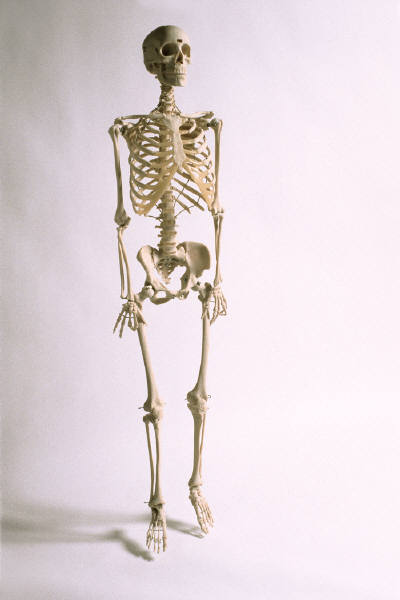
Osteology List
The following list contains the basic bones, structures, and landmarks that will be referred to during the Forensic Osteology Workshop. If you are not already familiar with these terms, please spend some time learning or reviewing them at the websites listed previously.

Clavicle (collar bone)
Scapula (shoulder blade)
scapular spine
glenoid fossa (cavity)
Humerus (upper arm bone)
head
anatomical neck
greater & lesser tubercles
medial & lateral epicondyle
Ulna (medial forearm bone)
Radius (lateral forearm bone)
Carpals (bones of the wrist - 8)
Metacarpals (bones of the hand - 5)
Phalanges (finger bones - 14)
Os Coxae (hip bone) - consists of three bones, ilium, ischium, and pubis, which have grown together to form a single bone. Be sure you can identify these three bones. They all join in a depression called the acetabulum, which is also where the head of the femur resides.
iliac crest
anterior superior iliac spine
greater sciatic notch
ischial tuberosity
head
neck
greater & lesser trochanter
medial & lateral condyle
Patella (knee cap)
Tibia (medial leg bone)
Fibula (lateral leg bone)
Tarsals (ankle bones - 7)
Calcaneus (heel bone/one of the tarsal bones)
Metatarsals (foot bones - 5)
Phalanges (toe bones - 14)
Axial Skeleton
Composed of 80 bones: 29 in the head, 25 in the thorax, and 26 in the vertebral column. The head bones include 22 skull bones (of which 8 are cranial and 14 are facial), 6 ear ossicles, and one hyoid. (No you wont need to know these numbers!)
Skull (cranium & face) only those names with an (*) will be tested on for this course.
Frontal (1)
Parietal (2)
Occipital (1)
foramen magnum
Temporal (2)
mastoid process
external auditory meatus
Sphenoid (1)
Zygomatic (2)
zygomatic arch
Maxilla (2)
Mandible (1)
Nasal (2)
Lacrimal (2)
Ethmoid (1)
Vomer (1)
Palatine (2)
Vertebrae
body
spinous process
transverse process
vertebral foramen
Cervical vertebrae (C1-C7)
the first cervical vertebra is the atlas
the second cervical vertebra is the axis
dens (odontoid process)
Thoracic vertebrae (T1-T12)
articular facets ( areas of transverse processes that articulate with tubercle of ribs)
Lumbar vertebrae (L1-L5)
Sacrum (five fused sacral vertebrae)
Coccyx (three to five fused coccygeal vertebrae)
Ribs (12 pairs -- upper 7 are "true", lower 5 are "false) The last two pairs of false ribs are called "floating" ribs.
Sternum (breast bone)